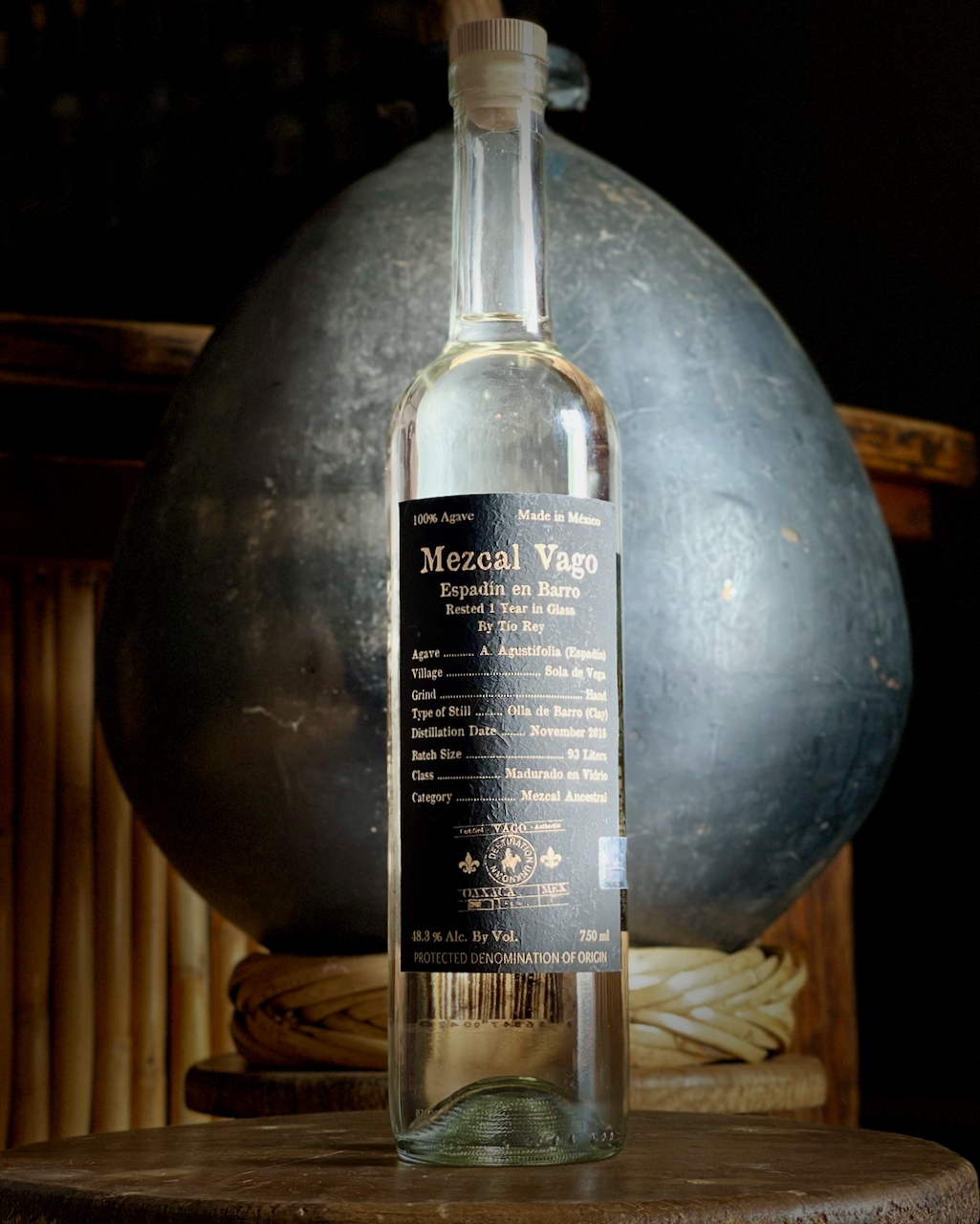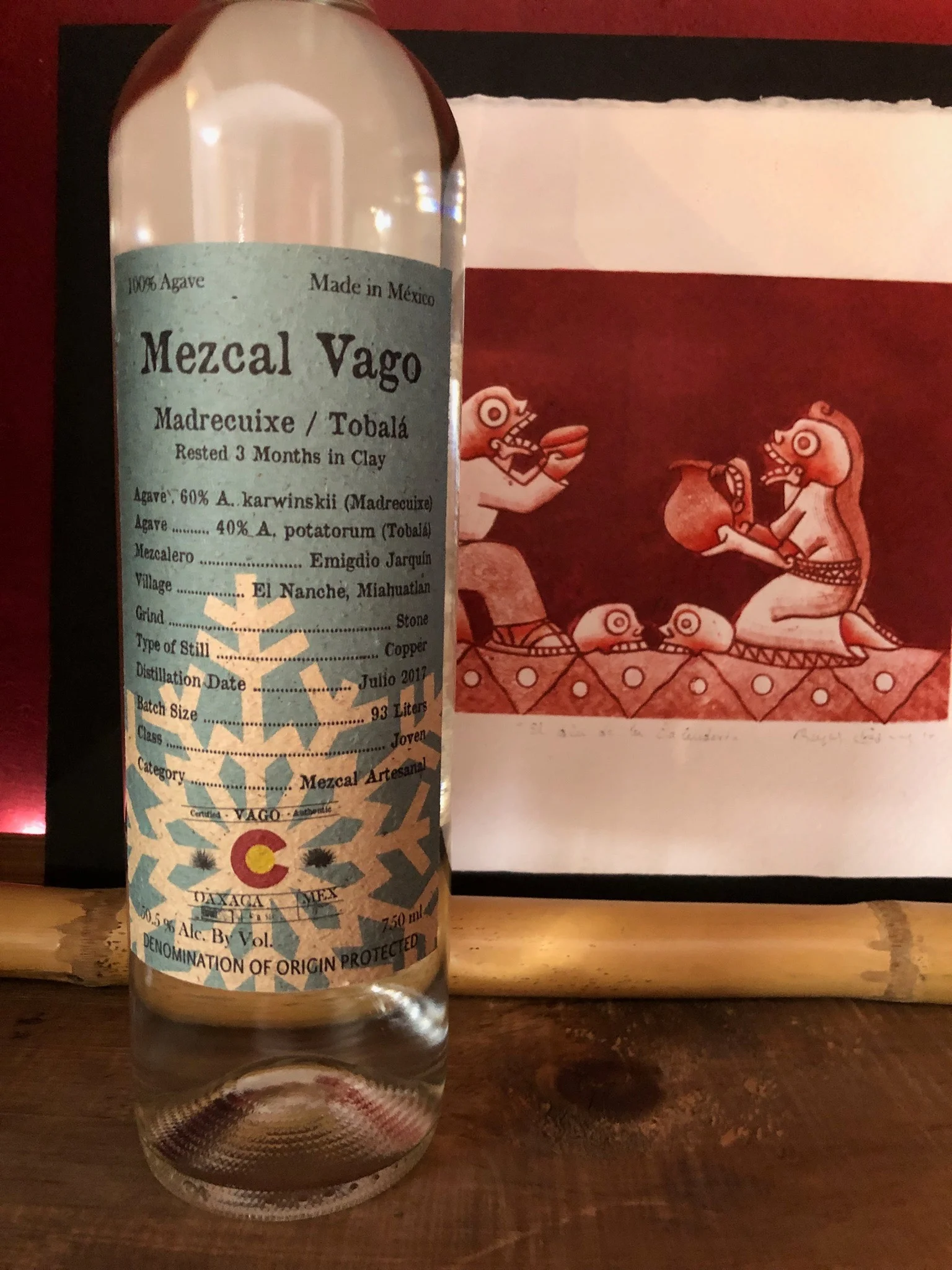Colorado Inaugural E-08/09-MCTOB-17
This 49-liter release of glass-aged mezcal is a special treat bottled for our friends in the great state of Colorado. It was produced in the Spring of 2017 at Emigdio Jarquín Ramirez’ palenque in Nanche, Miahuatlán, Oaxaca (16°23'51.4"N 96°33'03.5"W) and is the newest expression in our line of post-distillation blended mezcals.
For this extremely limited batch, we took 90 liters of a single-distilled 100% Madrecuixe mezcal that was produced in late February 0f 2017 to a bottling proof of 50.53% ABV and blended it with 60 liters of a double-distilled 100% Tobalá mezcal that was produced in April of 2017 to a bottling proof of 50.85% ABV. The resulting 150-liter blend was then split into 93-liters to experiment with our clay-aging process and another 54-liters left to rest in glass (3 liters were pulled from the 150 for certification testing).
While post-distillation blending and clay-aging are both somewhat rare techniques that we have experimented with in the past, this was the first time that we were blending and aging with a specific purpose in mind. We have always thought that the rich sweetness and grassy undertone of Madrecuixe would benefit from and complement the lighter floral, mint, and citrus notes of a Tobalá. It was just a matter of time before finding the right batches. After tasting several different proportions, some Madrecuixe heavy, some Tobalá dominant, we decided to focus on a predominantly Madrecuixe blend, in order to give the mezcal the body to hold up to spending time in the porous clay and the minerality it would impart. Over the course of the next few months, we would periodically siphon a small sample out of the clay cántaros to see how the flavor had evolved. We pulled it from clay after three months of rest and rested another two months in 18-liter glass garafone before being bottled in January.
Purists may argue that post-distillation is not the most traditional approach to mezcal, and we would agree. However, from time to time we do encounter a batch of mezcal that, while beautiful in its own right, may shine when rounded out with characteristics from another mezcal and result in a more balanced spirit. We also have occasionally utilized this practice when a particular batch was high in acids, or other compounds under the previous NOM certification limits. There is a saying that we follow here at Vago; we use it to help us continue to innovate, but not abandon or bastardize the knowledge and practices of those that came before us: “Rooted in tradition, but not stuck in the past.” It inspires us to look for ways to constantly improve what we are able to share with our friends. Not make cheaper or more efficient. Better. And ultimately, if it means we are going to be able to give more money directly to our mezcaleros, then the decision is clear.
In the glass, this batch of mezcal will have a full nose of lighter notes such as mint, white flower, dry hay, burlap, and garden-fresh starch vegetable (think of digging up and snapping a raw potato). Upon tasting, the palate is dominated up front by the rich, sweet notes and heavy body of cooked agave, buttercream frosting, and vibrant peppermint. There are also notes of cardamom and lime pulp. As the mid-palate begins to take hold, the sweet richness transitions towards grassy and vegetal notes, where minerality and wet soil begin to show with a slight menthol note. The finish is dominated by a stone-fruit sweetness and citrus from the Tobalá along with starch and lingering dust from the Madre Cuixe and a lingering minerality likely contributed by Emigdio’s mineral-rich water source and the clay-aging. The clay-aging, like most resting processes, rounds out the body and allows the different flavors to blend more smoothly. The clay also adds texture and creaminess to the body of the mezcal, making it a perfect compliment to mezcals that usually have a brighter, green finish.
Agave Madrecuixe
Agave Madrecuixe is one of several varieties of the Agave Karwinskii family. These agave typically grow on stalks that can reach up to 4 feet tall with the rosette or piña growing on top of the stalk, resulting in a plant that can reach heights of up to 7 feet. Agave in the Karwinskii family can often take between 15 and 18 years to mature.
Between the different sub-varieties, there are different ratios of stalk to piña which can affect the final flavor. The starches in the stalk are structured differently, such that they do not always break down during the roasting process. As a result, in sub-varieties like Cuixe and Madrecuixe that have more stalk in relation to the piña, this can result in mezcales that do have a core of agave sweetness that most are used to, but there is an overall dry and starchy quality to the mezcales that can linger on the palate. Madrecuixe typically has a larger piña than Cuixe, resulting in mezcales that do have that starchy, grassy note often associated with Cuixe, but with a touch more sweetness and body. One reason that Madrecuixe is so named is because they often grow as solitary plants surrounded by several Cuixe, as though they are protecting, or a “mother” (madre) plant. However, the Cuixe are not part of the Madrecuixe.
The distribution of Agave Karwinskii can be seen in the map below.
*Map provided by CONABIO website
Agave Tobalá
Agave Potatorum, or Tobalá are some of the most prized mezcal agaves in existence. Their small, basketball-sized pinas have a very high starch content and produce very light, sweet & floral mezcales. Unfortunately, the plants scarcity and high demand as well as inability to reproduce clonally have combined to severely threaten the sustainability of this variety.
Young children often scour the rocky slopes under the shade of oak trees to harvest undersized tobalás to bring to mezcaleros knowing they can still fetch top dollar. Their small yield and limited availability combine to drive the price. They are also notoriously difficult to cultivate, adding the labor of wild harvesting into their price. As a result of this increasing scarcity, Mezcal Vago is actively working to remove wild harvested Tobalá from our supply stream. We are also actively planting thousands of Tobalá seeds throughout the year.
These plants look similar to a. Cupreata, with which they share genes, but are comparatively small. Typically, they grow to a diameter of 3 – 4 ft and a meter tall, however they can get substantially bigger. Their leaves are very wide and spade like, with a gray/green color. They range extends between Puebla and Oaxaca at elevations between 4,000 and 7,500 feet, where they grow in pine and scrub oak forests with rocky soil, typically beneath the shade of large trees. The natural range of Tobalá can be seen in the map below.
*Map provided by CONABIO website
Emigdio Jarquín Ramirez
Emigdio distills outside of Miahuatlán de Porfirio Díaz. We are very proud and excited to have finally found a mezcalero from this area we can put in a Vago bottle. Miahuatlán is a historically important town in mezcal production as well as where both Aquilino and Tío Rey’s families emigrated from. By adding Emigdio to the family, we are able to extend the conversation of our history and tradition even further back in time.
Emigdio’s land is in the Nanche district of Miahuatlán de Porfirio Diaz, about 2 ½ hours directly South of Oaxaca City. The palenque sits at around 4,970 ft., among gently rolling hills and shallow arroyos in a semi-arid climate. In the surrounding area grows Agave Espadín, Mexicano Verde, Tobalá, Tepeztate, Arroqueño, Pulquero, Madre Cuixe, and Bicuixe (Cuixe).
Mezcal goes back in his family at least three generations, Emigdio having learned it from his grandfather. Their horno is a conical pit dug into the earth, which can hold up to 7 tons of Espadin. Emigdio usually roasts his agave for 5-7 days, which is on the longer end of an average roast. He then lets it rest in the sun to cool for one to two weeks.
They use a cement tahona lined with rocks and pulled by mule to crush their agave. Once crushed, they use four Ocote wood fermentation vats with volumes of 1,470, 1,600, 1,600, and 1,700 liters, which usually take around three days to ferment to completion.
Distillation is done in a 300 l. copper refrescador still. Refrescador is a technique that is common to the area surrounding Miahuatlan, but Vago has never used before. The still looks similar to a copper alembic still with a stainless steel cylinder surrounding it. This cylinder is then filled with water, allowing it to cool the upper part of the still. This upper chamber now acts as a condenser and sends the alcohol vapor back down into the boiler before being heated again and passing out of the still and into the condensing coil. This method essentially allows for two distillations during a single pass through the still. Cuts are made using a carrizo to test for ABV as well as taste and smell. A full capacity 300 l. still will produce, on average, 100 l. of mezcal in roughly 14 hours.
A full roast of 700 tons will produce up to 700 l. of mezcal depending upon the which agave is being used. ABV is then adjusted by using colas that have been rested with distilled water in order to preserve taste and mouthfeel. Like all Vago mezcal, Emigdio’s goes through a simple sediment filtration through a tubular cellulose filter before bottling. The bottling is done by hand in Oaxaca City. The very light filtration is the only way the mezcal is affected between when it was made on the palenque and how it ends up in the bottle.
















